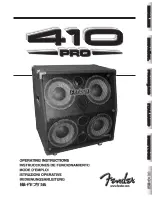
-> You may be looking at a faulty tube or another defect. In this case,
be sure to take the preamp to an authorized, professional service center.
-> Is there a connection (for example, via a shielded circuit) between the
amp and another device that is grounded via a power plug of its own?
Two or more circuits sharing a common electrical ground line can cause
audible hum. If low-frequency noise is emanating from your rig,
be sure to consult a specialist.
-> The amp and mains grounds are not connected properly or are altogether
disconnected. Have an experienced specialist check this.
-> Cords connected to the input or effect loops may not be shielded properly.
Replace them to check if this is indeed the case.
-> The amp or speaker cords may be picking up interference from powerful
magnetic fields (for example, of nearby power transformers or electrical motors).
Reposition the amp and connector cables.
-> The amp or speaker cords may be picking up radio signals, for example,
from activated mobile telephones or powerful local transmitting stations nearby.
Switch off mobile phones while troubleshooting noise problems.
-> The given power tube is defective and must be replaced if the electronic circuit
breaker continues to trip after several attempts to reset the Tube Monitoring
System by flipping the Standby switch off and back on again.
-> The amp has been overloaded, perhaps by excessive volume levels,
mains over-voltage, or the wrong output impedance (the impedance setting
does not match the connected speaker's impedance).
* The speaker is emitting humming noises:
* The electronic power amp protection circuit has tripped:
IMPORTANT, PLEASE NOTE: do not flip the Stand By switch off and on in short
time intervals if a P.T.M. LED (10, 11, 12, 13) indicates a tube failure. Let a few
minutes pass by before you engage the poweramp again after you have
switched it off!
20









































